Blog
Why Live with Pain and Numbness in Your Feet?
Understanding and Preventing Discomfort From Corns on the Feet
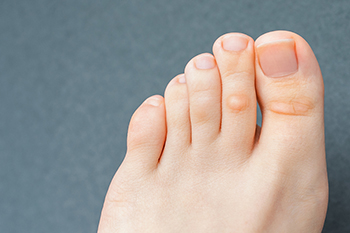
Corns are defined as small, but bothersome, patches of thickened skin, which can quietly disrupt our daily stride. These localized areas of pressure and friction often develop on the feet, particularly over areas that constantly rub against footwear. They are the skin's natural response to protect itself from irritation. However, when left untreated, corns can cause pain and discomfort. Prevention is the key to keeping corns at bay. Choosing shoes that fit well with ample toe room and cushioning can minimize friction. Regularly moisturizing the feet can help to keep skin supple and less prone to developing corns. Wearing orthotic inserts can help to provide proper arch support in addition to distributing pressure evenly. It is beneficial to recognize the importance of preventing corns on the feet, ensuring that each step remains comfortable and pain-free. If you have problematic corns on your feet, it is suggested that you consult with a podiatrist for effective relief options.
If you have any concerns regarding your feet and ankles, contact Elliot T. Udell, DPM of New York. Our doctor will treat your foot and ankle needs.
Corns: What Are They? and How Do You Get Rid of Them?
Corns can be described as areas of the skin that have thickened to the point of becoming painful or irritating. They are often layers and layers of the skin that have become dry and rough, and are normally smaller than calluses.
Ways to Prevent Corns
There are many ways to get rid of painful corns such as wearing:
- Well-fitting socks
- Comfortable shoes that are not tight around your foot
- Shoes that offer support
Treating Corns
Treatment of corns involves removing the dead skin that has built up in the specific area of the foot. Consult with Our doctor to determine the best treatment option for your case of corns.
If you have any questions please feel free to contact our office located in Hicksville, NY . We offer the newest diagnostic and treatment technologies for all your foot and ankle needs.
Prevention and Non-Surgical Solutions for Morton’s Neuroma
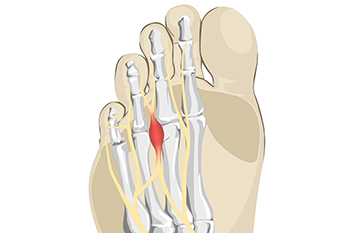
Morton's neuroma, a painful condition affecting the ball of the foot, can cast a shadow over daily activities. This ailment arises when tissue thickens between the third and fourth toes, causing discomfort and numbness. Wearing high heels, tight shoes, and repetitive foot stress are common contributors. Avoiding surgery is often a priority for many seeking relief. Embracing proper footwear is a pivotal step, and choosing shoes with ample toe space and cushioning can alleviate pressure on the affected area. Orthotic inserts can provide arch support, which can help to redistribute weight and reduce strain. Regularly massaging the foot, and taking anti-inflammatory medications can manage pain. It is beneficial to perform exercises that strengthen surrounding muscles and can aid in reducing symptoms. By adopting these strategies, individuals can potentially sidestep surgery and reclaim pain-free steps. If you have pain in this area of your foot, it is suggested that you consult a podiatrist who can offer you additional prevention techniques for Morton’s neuroma.
Morton’s neuroma is a very uncomfortable condition to live with. If you think you have Morton’s neuroma, contact Elliot T. Udell, DPM of New York. Our doctor will attend to all of your foot care needs and answer any of your related questions.
Morton’s Neuroma
Morton's neuroma is a painful foot condition that commonly affects the areas between the second and third or third and fourth toe, although other areas of the foot are also susceptible. Morton’s neuroma is caused by an inflamed nerve in the foot that is being squeezed and aggravated by surrounding bones.
What Increases the Chances of Having Morton’s Neuroma?
- Ill-fitting high heels or shoes that add pressure to the toe or foot
- Jogging, running or any sport that involves constant impact to the foot
- Flat feet, bunions, and any other foot deformities
Morton’s neuroma is a very treatable condition. Orthotics and shoe inserts can often be used to alleviate the pain on the forefront of the feet. In more severe cases, corticosteroids can also be prescribed. In order to figure out the best treatment for your neuroma, it’s recommended to seek the care of a podiatrist who can diagnose your condition and provide different treatment options.
If you have any questions, please feel free to contact our office located in Hicksville, NY . We offer the newest diagnostic and treatment technologies for all your foot care needs.
Foot Surgery for Rheumatoid Arthritis May Improve Mobility

Rheumatoid arthritis, abbreviated RA, is a chronic autoimmune condition that can severely impact the joints, including those in the feet. When conservative treatments fail to provide adequate relief, foot surgery becomes a viable option for managing RA and related foot deformities. Surgical procedures aim to correct joint alignment, reduce inflammation, and improve overall foot function. Common surgical interventions for RA in the feet include a synovectomy, which is the removal of the inflamed joint lining, tendon repair or transfer, joint fusion, and joint replacement. It's important to note that foot surgery for RA is considered a last resort when other treatments have proven ineffective. It is beneficial for patients to work closely with their podiatrist to determine the most suitable surgical approach based on individual needs and medical history. While foot surgery may involve a recovery period, it can significantly enhance mobility, reduce pain, and ultimately improve the quality of life for those living with RA. It is suggested that you consult with a podiatrist if this condition affects you.
Foot surgery is sometimes necessary to treat a foot ailment. To learn more, contact Elliot T. Udell, DPM of New York. Our doctor will assist you with all of your foot and ankle needs.
When Is Surgery Necessary?
Foot and ankle surgery is generally reserved for cases in which less invasive, conservative procedures have failed to alleviate the problem. Some of the cases in which surgery may be necessary include:
- Removing foot deformities like bunions and bone spurs
- Severe arthritis that has caused bone issues
- Cosmetic reconstruction
What Types of Surgery Are There?
The type of surgery you receive will depend on the nature of the problem you have. Some of the possible surgeries include:
- Bunionectomy for painful bunions
- Surgical fusion for realignment of bones
- Neuropathy decompression surgery to treat nerve damage
Benefits of Surgery
Although surgery is usually a last resort, it can provide more complete pain relief compared to non-surgical methods and may allow you to finally resume full activity.
Surgical techniques have also become increasingly sophisticated. Techniques like endoscopic surgery allow for smaller incisions and faster recovery times.
If you have any questions please feel free to contact our office located in Hicksville, NY . We offer the newest diagnostic and treatment technologies for all your foot and ankle needs.
Eczema and Blisters on the Feet
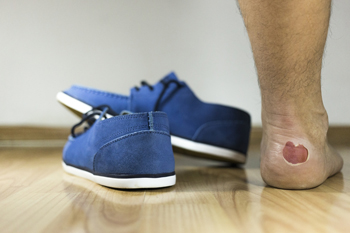
Foot dyshidrotic eczema, also known as pompholyx, is a skin condition characterized by small, intensely itchy blisters that appear on the soles of the feet and edges of the toes. This condition tends to flare up for a few weeks and in some cases, can be chronic. It is most common in adults aged 20-40, with a higher prevalence among females. Symptoms of foot dyshidrotic eczema include a burning or prickling sensation on the skin, followed by the sudden eruption of tiny blisters that may weep and become infected. This condition can cause pain, itching, fluid-filled blisters, sweaty skin, dry and flaky skin after blisters clear, and possible dark spots for individuals with darker skin tones. The exact cause of foot dyshidrotic eczema is unknown, but it is thought to be genetic and can be linked to hypersensitivity to certain allergens, such as exposure to metals or fungal infections like athlete's foot, and excessively sweaty feet. Stress and warm weather may also lead to flare-ups. If you have anything resembling this condition, it is strongly suggested that you make an appointment with a podiatrist as soon as possible for a proper diagnosis and treatment.
Blisters may appear as a single bubble or in a cluster. They can cause a lot of pain and may be filled with pus, blood, or watery serum. If your feet are hurting, contact Elliot T. Udell, DPM of New York. Our doctor can provide the care you need to keep you pain-free and on your feet.
Foot Blisters
Foot blisters are often the result of friction. This happens due to the constant rubbing from shoes, which can lead to pain.
What Are Foot Blisters?
A foot blister is a small fluid-filled pocket that forms on the upper-most layer of the skin. Blisters are filled with clear fluid and can lead to blood drainage or pus if the area becomes infected.
Symptoms
(Blister symptoms may vary depending on what is causing them)
- Bubble of skin filled with fluid
- Redness
- Moderate to severe pain
- Itching
Prevention & Treatment
In order to prevent blisters, you should be sure to wear comfortable shoes with socks that cushion your feet and absorb sweat. Breaking a blister open may increase your chances of developing an infection. However, if your blister breaks, you should wash the area with soap and water immediately and then apply a bandage to the affected area. If your blisters cause severe pain it is important that you call your podiatrist right away.
If you have any questions, please feel free to contact our office located in Hicksville, NY . We offer the newest diagnostic and treatment technologies for all your foot care needs.
Do Your Child's Feet Hurt?
Simple Steps That Can Help Diabetic Patients
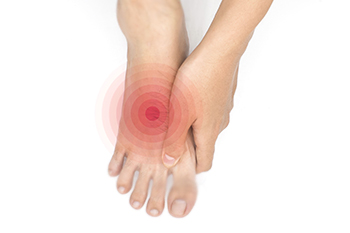
Many diabetic patients realize the importance of maintaining proper foot care. This can be an overwhelming task to accomplish, and it is beneficial that small steps are taken that can simplify the process. It is important to engage in a gentle exercise program frequently, and this can help to improve blood circulation to the feet, as well as the overall body. Eating healthy foods that can comprise a healthy diet may help to monitor glucose levels, and existing nerve damage may be controlled. Stress can raise blood pressure, and elevating the feet at the end of the day may give them a needed rest and may help to reduce existing stress. Additionally, inspecting the feet daily can reveal any cuts and scrapes that have developed. Many people who are diabetic experience neuropathy, which is the inability to feel sensation in the feet. Family members or caregivers may help patients to see the soles of their feet by helping them to use a mirror. If you have diabetes, it is strongly suggested that you are under the care of a podiatrist who can help you to manage this condition.
Diabetic foot care is important in preventing foot ailments such as ulcers. If you are suffering from diabetes or have any other concerns about your feet, contact Elliot T. Udell, DPM from New York. Our doctor can provide the care you need to keep you pain-free and on your feet.
Diabetic Foot Care
Diabetes affects millions of people every year. The condition can damage blood vessels in many parts of the body, especially the feet. Because of this, taking care of your feet is essential if you have diabetes, and having a podiatrist help monitor your foot health is highly recommended.
The Importance of Caring for Your Feet
- Routinely inspect your feet for bruises or sores.
- Wear socks that fit your feet comfortably.
- Wear comfortable shoes that provide adequate support.
Patients with diabetes should have their doctor monitor their blood levels, as blood sugar levels play such a huge role in diabetic care. Monitoring these levels on a regular basis is highly advised.
It is always best to inform your healthcare professional of any concerns you may have regarding your feet, especially for diabetic patients. Early treatment and routine foot examinations are keys to maintaining proper health, especially because severe complications can arise if proper treatment is not applied.
If you have any questions please feel free to contact our office located in Hicksville, NY . We offer the newest diagnostic and treatment technologies for all your foot and ankle needs.
Understanding Foot Ulcers
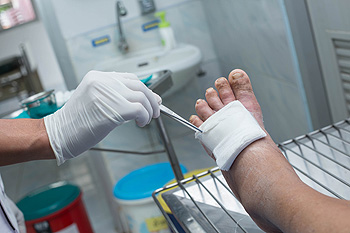
Foot ulcers are open wounds on the feet resulting from skin breakdown. They may be deep, discolored sores that discharge pus, affecting deeper layers of the skin, and potentially spreading to muscles, tendons, or bones. Often caused by injury, friction, or pressure, ulcers are more likely to develop in people who have diabetes and peripheral neuropathy, which reduces foot sensation and can impede skin healing, raising ulcer risks. These ulcers can be painful. Untreated foot ulcers can lead to infections and complications and require serious medical intervention. To prevent ulcers, wear well-fitting shoes and regularly check your feet. If you have foot wounds, it is suggested that you seek prompt examination and treatment from a podiatrist.
Wound care is an important part in dealing with diabetes. If you have diabetes and a foot wound or would like more information about wound care for diabetics, consult with Elliot T. Udell, DPM from New York. Our doctor will assess your condition and provide you with quality foot and ankle treatment.
What Is Wound Care?
Wound care is the practice of taking proper care of a wound. This can range from the smallest to the largest of wounds. While everyone can benefit from proper wound care, it is much more important for diabetics. Diabetics often suffer from poor blood circulation which causes wounds to heal much slower than they would in a non-diabetic.
What Is the Importance of Wound Care?
While it may not seem apparent with small ulcers on the foot, for diabetics, any size ulcer can become infected. Diabetics often also suffer from neuropathy, or nerve loss. This means they might not even feel when they have an ulcer on their foot. If the wound becomes severely infected, amputation may be necessary. Therefore, it is of the upmost importance to properly care for any and all foot wounds.
How to Care for Wounds
The best way to care for foot wounds is to prevent them. For diabetics, this means daily inspections of the feet for any signs of abnormalities or ulcers. It is also recommended to see a podiatrist several times a year for a foot inspection. If you do have an ulcer, run the wound under water to clear dirt from the wound; then apply antibiotic ointment to the wound and cover with a bandage. Bandages should be changed daily and keeping pressure off the wound is smart. It is advised to see a podiatrist, who can keep an eye on it.
If you have any questions, please feel free to contact our office located in Hicksville, NY . We offer the newest diagnostic and treatment technologies for all your foot care needs.
How Can Being Overweight Affect the Feet?
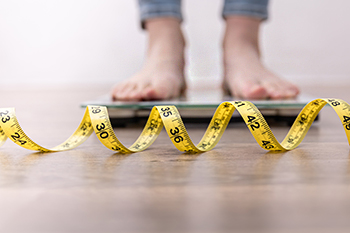
The feet are the foundation of the body, carrying its weight with every step. When someone is obese, the added force on the feet can take its toll, and foot problems easily emerge. Obesity, which has become a national problem, can negatively affect the structure of your feet. Excess weight can weaken the arches, which both support your body and absorb shock. As the arch becomes less effective, flat feet are likely to develop, and added stress is placed on the plantar fascia under the foot. When this band of tissue suffers from overuse, a painful condition known as plantar fasciitis develops, causing inflammation. Obesity can also cause damage to the nerves and muscles in the feet, which can affect the ability to walk. In addition, the risk of developing Achilles tendonitis and osteoarthritis increase with added body weight. Not only that, but the weakening of the heel can contribute to instability and increase the possibility of ankle injury or falling. If you have weight-related foot problems, it is suggested that you make an appointment with a podiatrist for testing and treatment options.
The more you weigh, the harder your feet must work to support your body. If you’re an obese individual and are concerned about your feet, contact Elliot T. Udell, DPM from New York. Our doctor can provide the care you need to keep you pain-free and on your feet.
Obesity and Your Feet
People who are overweight are putting more pressure on their ankles, knees, and hips as well as their feet. This unfortunately can lead to variety of different issues.
Problems & Complications Stemming from Obesity
- When the body is overweight, it tries to compensate by changing the way that it moves. An obese person may lean forward and put extra weight on the wrong part of the foot. This puts unnecessary stress on the feet.
- Obese people are also more likely to develop type II diabetes which is a condition that causes a lot of foot problems. People with diabetes often don’t feel the cuts and sores that they may have on their feet, which can lead to more complicated and severe issues.
- Plantar fasciitis is another foot condition that can be caused by obesity. Plantar fasciitis is an inflammation of the tissue along the bottom of the foot, which causes pain and stiffness while walking and climbing stairs.
If you have any questions, please feel free to contact our office located in Hicksville, NY . We offer the newest diagnostic and treatment technologies for all your foot care needs.
Aging Affects the Feet
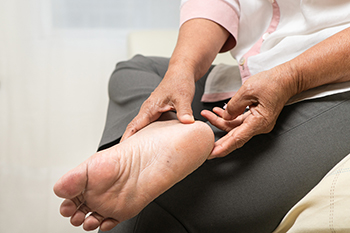
As one ages, their feet also age. A common sign of aging feet is the inability to absorb impact, also termed a loss of springiness. This is the result of loosening of the tendons that hold the arch in place. Additionally, the joints can become less flexible as one ages, especially if osteoarthritis sets in, further reducing the flexibility of the feet. Rheumatoid arthritis, gout, and obesity are other factors that may affect the foot’s suppleness. Another effect of aging is decreased muscle strength. Add to that a natural thinning of the bones, which can become worse by smoking and not intaking adequate vitamin D amounts. This increases the chance of getting stress fractures. Another way that aging affects the feet is a loss of resilience in the skin, which reduces its cushioning. Furthermore, the fat pads, particularly under the ball of the foot and the heel begin to thin out, increasing the chances of having foot pain. Wearing proper footwear is generally the easiest way to lessen the effects of aging on the feet. Shoes with ample cushioning and arch support are essential. For help with foot problems caused by aging, it is suggested that you make an appointment with a podiatrist.
Proper foot care is something many older adults forget to consider. If you have any concerns about your feet and ankles, contact Elliot T. Udell, DPM from New York. Our doctor can provide the care you need to keep you pain-free and on your feet.
The Elderly and Their Feet
As we age we start to notice many changes in our body, but the elder population may not notice them right away. Medical conditions may prevent the elderly to take notice of their foot health right away. Poor vision is a lead contributor to not taking action for the elderly.
Common Conditions
- Neuropathy – can reduce feeling in the feet and can hide many life-threatening medical conditions.
- Reduced flexibility – prevents the ability of proper toenail trimming, and foot cleaning. If left untreated, it may lead to further medical issues.
- Foot sores – amongst the older population can be serious before they are discovered. Some of the problematic conditions they may face are:
- Gouging toenails affecting nearby toe
- Shoes that don’t fit properly
- Pressure sores
- Loss of circulation in legs & feet
- Edema & swelling of feet and ankles
Susceptible Infections
Diabetes and poor circulation can cause general loss of sensitivity over the years, turning a simple cut into a serious issue.
If you have any questions please feel free to contact our office located in Hicksville, NY . We offer the newest diagnostic and treatment technologies for all your foot and ankle needs.
More...
Exercises for Flat Feet
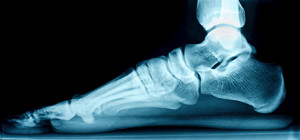
Children are naturally born with flat feet, and by the time they are teenagers, the arch usually develops normally. However, there are various circumstances where the arches either do not develop or they fall. These include injuries, obesity, genetics, and arthritis. Those with neurological or muscular diseases may also be more prone to having flat feet. Wearing orthotics or arch supports, and performing certain stretches, can reduce pain from fallen arches or help correct them. Examples of exercises that might help raise, strengthen, and lengthen the arches are heel stretches and tennis or golf ball rolls. Stretch your heels by standing with your hands resting on a wall at eye level. Keep one leg forward and the other extended behind you. Press both heels into the floor. Then bend one leg at a time toward the wall with the opposite heel pressed into the floor and hold this position for 30 seconds. Repeat on each side four times. For the tennis or golf ball roll, sit in a chair with a ball under one foot. Keep a straight spine and roll the ball under your foot, focusing on the arch. Do this for two to three minutes and then change feet. If you have flat feet and they are causing you discomfort, it is suggested that you consult with a podiatrist who can provide you with additional exercise options and further treatment that is right for you.
Flatfoot is a condition many people suffer from. If you have flat feet, contact Elliot T. Udell, DPM from New York. Our doctor will treat your foot and ankle needs.
What Are Flat Feet?
Flatfoot is a condition in which the arch of the foot is depressed and the sole of the foot is almost completely in contact with the ground. About 20-30% of the population generally has flat feet because their arches never formed during growth.
Conditions & Problems:
Having flat feet makes it difficult to run or walk because of the stress placed on the ankles.
Alignment – The general alignment of your legs can be disrupted, because the ankles move inward which can cause major discomfort.
Knees – If you have complications with your knees, flat feet can be a contributor to arthritis in that area.
Symptoms
- Pain around the heel or arch area
- Trouble standing on the tip toe
- Swelling around the inside of the ankle
- Flat look to one or both feet
- Having your shoes feel uneven when worn
Treatment
If you are experiencing pain and stress on the foot you may weaken the posterior tibial tendon, which runs around the inside of the ankle.
If you have any questions please feel free to contact our office located in Hicksville, NY . We offer the newest diagnostic and treatment technologies for all your foot and ankle needs.
Wounds That Don't Heal Need to Be Checked
Tips for Having More Attractive Feet
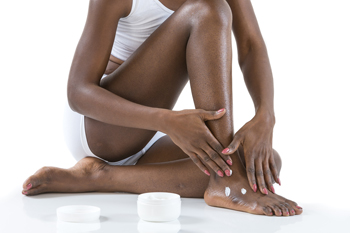
Professional pedicures are an obvious step to take if you want to have more attractive feet, but sometimes this is not possible. There are routines that can be done at home that an individual can follow to help to ensure their feet are healthy and looking nice Following these steps for everyday foot care can save you time and money. This can begin with soaking the feet. Adding Epsom salts to warm water can cleanse the feet, soften them, and make the toenails easier to trim. After drying the feet, a foot file or large nail file can be used to file corns or calluses. This can be done gently until the skin feels smoother. Next, the feet can be exfoliated with an appropriate scrub that can remove dead skin cells and soften dry skin. It is important to trim the toenails straight across and smooth the edges with a nail file. This can be followed by moisturizing the feet and completed by polishing your toenails. In performing this process, if you encounter any wounds on your feet or areas of infection, it is suggested to see a podiatrist who can examine your feet and tend to any problem areas.
Everyday foot care is very important to prevent infection and other foot ailments. If you need your feet checked, contact Elliot T. Udell, DPM from New York. Our doctor can provide the care you need to keep you pain-free and on your feet.
Everyday Foot Care
Often, people take care of their bodies, face and hair more so than they do for their feet. But the feet are a very important aspect of our bodies, and one that we should pay more attention to. Without our feet, we would not be able to perform most daily tasks.
It is best to check your feet regularly to make sure there are no new bruises or cuts that you may not have noticed before. For dry feet, moisturizer can easily be a remedy and can be applied as often as necessary to the affected areas. Wearing shoes that fit well can also help you maintain good foot health, as well as making it easier to walk and do daily activities without the stress or pain of ill-fitting shoes, high heels, or even flip flops. Wearing clean socks with closed shoes is important to ensure that sweat and bacteria do not accumulate within the shoe. Clean socks help to prevent Athlete’s foot, fungi problems, bad odors, and can absorb sweat.
If you have any questions please feel free to contact our office located in Hicksville, NY . We offer the newest diagnostic and treatment technologies for all your foot and ankle needs.
Unsightly Cracked Heels
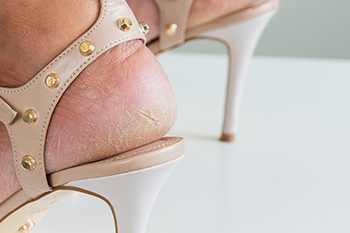
Having cracked heels is a foot condition that can cause embarrassment. It is defined as cracks that develop in the skin of the heels and may become fissures if conservative treatment does not work. Cracked heels can happen for a variety of reasons, including wearing shoes that have an open back, or standing on hard surfaces for the majority of the day. Additionally, frequently wearing flip-flops may lead to developing cracked heels, as a result of the lack of support most of these types of shoes have. Elderly people may notice they have cracked heels. The heel pads can lose elasticity, possibly causing cracked heels. People who are overweight may also be prone to getting cracked heels, which can be from the extra weight the heels must endure. Relief may be found when the feet are soaked in warm water, followed by applying a good moisturizer on them. If you have cracked heels, it is strongly suggested that you are under the care of a podiatrist who can offer you effective prevention and relief methods.
Cracked heels are unsightly and can cause further damage to your shoes and feet. If you have any concerns, contact Elliot T. Udell, DPM from New York. Our doctor can provide the care you need to keep you pain-free and on your feet.
Cracked Heels
Cracked heels appear unappealing and can make it harder for you walk around in sandals. Aside from looking unpleasant, cracked heels can also tear stockings, socks, and wear out your shoes. There are several methods to help restore a cracked heel and prevent further damage.
How Do You Get Them?
Dry skin is the number one culprit in creating cracked heels. Many athletes, walkers, joggers, and even swimmers suffer from cracked heels. Age and skin oil production play a role to getting cracked heels as well.
Promote Healing
Over the counter medicines can help, especially for those that need instant relief or who suffer from chronic dry feet.
Wear Socks – Wearing socks with medicated creams helps lock in moisture.
Moisturizers – Applying both day and night will help alleviate dryness which causes cracking.
Pumice Stones – These exfoliate and remove dead skin, which allows for smoother moisturizer application and better absorption into the skin.
Change in Diet
Eating healthy with a well-balanced diet will give the skin a fresh and radiant look. Your body responds to the kinds of food you ingest. Omega-3 fatty acids and zinc supplements can also revitalize skin tissue.
Most importantly, seek professional help if unsure how to proceed in treating cracked heels. A podiatrist will help you with any questions or information needed.
If you have any questions, please feel free to contact our office located in Hicksville, NY . We offer the newest diagnostic and treatment technologies for all your foot care needs.



